A hyphen hydrogen energy shareholder says a coalition of European countries, including Belgium, The Netherlands, and Germany, will cover the risks of the Hyphen Hydrogen Energy green hydrogen project in Namibia.
The German government, however, said it will not cover the business risk of the US$10 billion Hyphen Hydrogen Project situated south of Namibia.
These latest comments come amid concerns from non-governmental organisations that the government will pump billions of taxpayers’ dollars into the experimental energy project.
There is a difference between credit risk and offtake/price risk.
If a project like Hyphen receives a lot of sovereign credit support, then it can offer its product at lower prices, and may not require a sovereign offtake guarantee, Enertrag project director Patrick Stein-Kaempfe said in a recent interview with The Namibian.
Enertrag is a co-owner of Hyphen.
He said if the credit support is not sufficient, a sovereign offtake guarantee may be required.
For the early days during which the price of carbon is high enough (for a few years?), Germany has created H2Global, and Europe has created the Hydrogen Bank for the purpose of addressing price/offtake risk and stimulating demand, Stein-Kaempfe said.
Flasbarth is referring to Germany being willing to discuss a partial offtake risk guarantee (in addition to the credit support already offered).
“This is okay for us, as we are also getting lots of credit support,” he said.
The German state secretary for economic development said Germany would only cover part of the risk associated with the price of hydrogen, but not the business risk.
He added that the price support would last for a few years only.

PRICE ISSUES
The current estimated selling price for green hydrogen produced in Namibia is between US$5 and US$8 per kilogram.
However, global consulting firm McKenzie has projected that this price could potentially decrease to a range of US$1 to US$2 per kilogram by the year 2030.
At such export prices it remains unclear how Hyphen would be able to get offtake agreements in the early years of operations and hence demonstrate that it is a bankable project.
This raises the question of who will provide the remaining price and credit risk cover for the US$10-billion Hyphen Hydrogen Energy project, which is equivalent to Namibia’s whole gross domestic product.
Senior Namibian government officials involved in green hydrogen say they are not aware of any Namibian government loan guarantees.
The commonly held view in finance and business circles is that once the two-year US$100-million feasibility study is completed in 2026 and if the project proves commercially feasible or even marginal, the government of Namibia will guarantee the loan necessary for the project by using its future oil revenue.
The government of Mozambique undertook a similar measure several years ago using Mozambique’s future gas revenue to guarantee questionable fisheries projects.
EU, UK DEPENDENCE
In the meantime, European Union (EU) countries and the United Kingdom are increasing their dependence on North African green electricity and green hydrogen that will be generated by countries like Morocco, Tunisia, Egypt, Saudi Arabia and Oman.
Like Namibia, they have abundantly cheap land, sunshine and wind
The outgoing EU commissioner for energy, Kadri Simson, during the EU’s press conference at the Global Hydrogen Summit said “we are principally concerned with our dependence on Russia”.
The EU delegation explained further that it seemed unfazed about Europe’s increasing dependence on energy from countries that are volatile and politically unstable.
The ease of highly disruptive terrorist actions against international infrastructure such as high-voltage power lines and green hydrogen pipelines that will transmit power under the Mediterranean from Morocco, Tunisia and Egypt to European countries, appeared to be of little concern to the commissioner.
A LESSON LEARNED
EU ambassador to Namibia Ana Beatriz Martins said: “We would like to clarify that the EU has learned a valuable lesson from the energy crisis following Russia’s illegal war of aggression against Ukraine.”
She added: “We cannot be dependent on a single supplier for our energy needs, nor should we be dependent on one type of energy or only address the supply side of our energy market.”?
The EU ambassador said this regarding the risks of increased dependence on the Middle East.
The EU has made agreements with a wide variety of partners in the region and outside.
While any potential source could be disrupted due to natural disasters or other crises, the diversification should ensure a reliability of supply.
The Namibian asked senior government officials whether the German government would be funding the feasibility study of the Hyphen project, but subsequently representatives of both the German government as well as Hyphen denied any direct German involvement.
They also denied that the study would be undertaken by Hyphen itself with the involvement of the Namibian government as a substantial shareholder.
Hyphen recently contracted ILF Consulting, a large international engineering firm, to start the process of developing the Lüderitz-based Hyphen Hydrogen Energy project, which states that it is expected to produce one million tonnes of ammonia by 2027.
It is unknown how this ambitious target will be met, given that the two-year feasibility study has yet to commence.
Questions remain as to precisely why the EU would support Namibian green hydrogen projects to the extent of committing to mobilise a total of one billion euro (N$19 billion) of public and private money, which was announced in 2023.
The EU clearly has an interest in energy security, with Namibia being widely seen as far more stable than the North African and Middle Eastern countries, even though transport costs of hydrogen will be higher from Namibia.
This is equally true of two other countries which could supply Europe – Chile and Australia.
Both are politically stable potential sources of green hydrogen supply, but far more expensive in terms of shipping to the EU market.
Thus these three countries, with abundant land, sun and wind, constitute a second tier of energy derisking for Europe, and that would seem to be the main reason for the apparent financial generosity to Namibia.
TALKING TOO MUCH
Civil society has over the years raised red flags about the green hydrogen project, which has been steamrolled by the Presidency.
Critics accused the company of refusing to provide information to the public, including the blunt refusal to make public all information even to lawmakers.
Last year, Swapo secretary general Sophia Shaningwa told Swapo parliamentarian Tjekero Tweya to “shut up”? as he has allegedly been “talking too much”.
Tweya, as chair of the parliamentary standing committee on natural resources, made his and other lawmakers’ displeasure known after James Mnyupe, the late president Hage Geingob’s hydrogen team leader, avoided appearing in person to explain the green hydrogen scheme to parliamentarians.
Mnyupe and his team are accused of “strategically” releasing bits of information about the ambitious project touted at more than N$200 billion.
Namibia reportedly opted to borrow money to acquire 24% equity in Hyphen Hydrogen Energy, a company selected without going through the country’s open public bidding process.
Most of the money is expected to come through concessional loans that Germany and The Netherlands seem to have brokered for Namibia.
- Roman Grynberg is a Polish-born professor of economics, author, and academic.
Stay informed with The Namibian – your source for credible journalism. Get in-depth reporting and opinions for
only N$85 a month. Invest in journalism, invest in democracy –
Subscribe Now!










